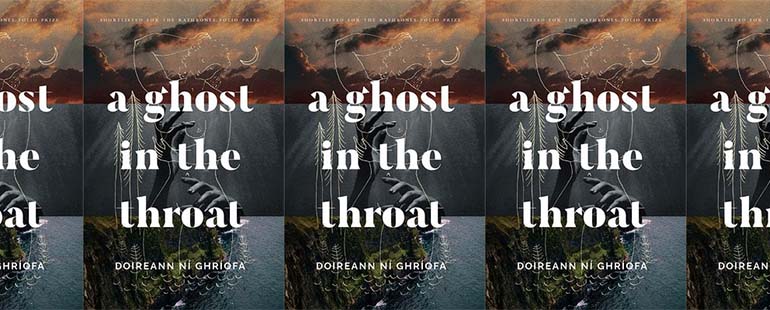What is A Ghost in the Throat For?

In the opening pages of A Ghost in the Throat (2020), Doireann Ní Ghríofa asserts, again and again, “This is a female text.” This phrase returns and refracts throughout this book, limning the possibilities of a female text—what it means to be one, what it means to create one. A Ghost in the Throat is Ní Ghríofa’s fourth book, following three collections of poetry and a series of innovative collaborative projects, all of which have received much-deserved accolades. And yet, A Ghost in the Throat is also a book with a central anxiety familiar to artists in less auspicious parts of their careers: the question “What’s all this for, then?” The two interrogations taken together provide a kind of spine for the book—flexible, yes, and sturdy enough to bear the weight of both maker and made, but subject to familiar pains—that is intensely focused on women’s work and women’s narratives but capacious enough as an ars poetica to sustain a multitude of passions and callings.
The question of purpose in the book is posed directly. A public health nurse visits the narrator shortly after she and her infant daughter, born by emergency cesarean section, come home after a lengthy period in neonatal intensive care. On the kitchen table, Ní Ghríofa has left her folders of notes and annotated photocopies—the things that will birth this book—and the nurse, leafing idly through it, asks if she’s taking a night class. When confronted with the negative, the nurse asks, “So what’s all this for, then?”
The woman’s judgement is unsubtle; a mother of four children under six, including the new and fragile daughter, surely has better things on which to spend her time. In the larger picture of the book—and, one feels, the artist’s life, every artist’s life—the question becomes a haunting, one of several that linger in the book’s doorways. It is tempting to think that the book answers the question itself: by existing (published, award-winning), it’s obvious. A Ghost in the Throat, though, has a more interesting, more troubled answer lodged between the strange sustenances of altruistic exhaustion and unrelenting curiosity.
The chimeric nature of the book itself further complicates its central thematic queries. A Ghost in the Throat is, at first glance, a memoir of translation: Ní Ghríofa sets out to translate the 18th-century “Caoineadh Airt Uí Laoghaire” (“The Keen for Art Ó Laoghaire,” also sometimes Anglicized as “The Keen for Art O’Leary”), and the book is how she came to do it. The “Caoineadh” recounts and laments, in traditional fashion, the murder-by-ambush of Art Ó Laoghaire through the voice—primarily—of his widow, Eibhlín Dubh Ní Chonaill. Eibhlín’s keen is also testament to the details of their marriage, passionate and richly textured with the trappings of their life together, and the clearest record of her voice and interior self. The author’s impulse to translate an oft-translated text is familiar; she finds the existing translations inadequate, flat, unsatisfying. In the volume, the reader is offered the chance to assess the translation itself. The “Caoineadh” in its original Irish and Ní Ghríofa’s English translation of it occupies the book’s final pages, and the reader does not have to be a scholar of the Irish language nor poetry generally to appreciate the living energy of Ní Ghríofa’s work, the deceptive simplicity and felt passions of the text as she has rendered it.
But A Ghost in the Throat spends strikingly little time on the actual act of translation, the word by word and line by line wrestling one might expect. Ní Ghríofa confines her overt discussion of translation to a bare handful of pages, and the process is largely conveyed through the metaphor of homemaking, rather than more literally: “In Italian, the word stanza means ‘room’. If there are times when I feel ill-equipped and daunted by the expertise of those who have walked these rooms before me, I assure myself that I am simply homemaking, and this thought steadies me, because tending to a room is a form of labour I know that I can attempt as well as anyone.” Where she does agonize over phrasing, she cloaks it in figurative and domestic language: she has forgotten to vacuum under a chair; the window-washing leaves streaks. By the end of this process, she finds the rooms of her translation—like the rooms in a house full of small children—are imperfect. Something, Ní Ghríofa feels, is missing, something that will bring Eibhlín Dubh Ní Chonaill’s voice to life.
And so the project evolves. The author will seek Eibhlín’s story, excavate it past the edges of the keen. In this capacity, A Ghost in the Throat becomes a biography. Indeed, it won the James Tait Black Biography Prize, and the architecture of Ní Ghríofa’s research, embedded in the text itself—library requests and site visits, even a few precious images of hand-written names of elusive figures—could assert itself and take precedence, making this a female text of a very specific sort by being a book about a woman’s life, assembled by a woman. Through the search for Eibhlín’s life, though, Ní Ghríofa’s own story persists—even when it seems that erasure is the truest heart of it. It is erasure that binds the two together in most intimate fashion. From the beginning of the book, Ní Ghríofa embraces a kind of self-obliteration through motherhood. As she lists the endless tasks of her stay-at-home mothering for three—and eventually four—young children, she writes, “In such erasure lies joy.” She is at once speaking of the physical erasure and striking out of completed tasks on a physical list but also of being freed from all but the tasks themselves. “I like to be in control,” she writes. The lists and the tasks and the never-ending process of mothering—including and specifically breastfeeding—provide that sense of control even as it effaces her. Or perhaps it is satisfying because it is effacing: “As I clean, my labour makes of itself an invisibility. If each day is a cluttered page, then I spend my hours scrubbing its letters. In this, my work is a deletion of a presence.” When she applies her labor to Eibhlín’s life, the impulse inverts: from a history of deletions, Ní Ghríofa seeks to reveal Eibhlín.
Paradoxically, in asserting this desire to bring Eibhlín’s own presence to the fore, Ní Ghríofa subsumes her own. At the moment she decides she will turn her attention past the poem and into the life of its maker, she writes, “Once this thought comes to me, my heart grows quick. I could donate my days to finding hers, I tell myself, I could do that, and I will.” This giving impulse is now familiar. In previous pages, Ní Ghríofa shares how girls are encouraged to give and give from a young age: to offer up the coveted toy to the crying companion, to donate the long hair they’ve grown. Even beyond the sleepless rush of nighttime feedings and this scholarship that claws into any precious margin, Ní Ghríofa relates her experience in donating her own breast milk to a milk bank. As the breast pump runs, the flesh is drained, the cylinder filled. The mother is exhausted, but the spirit is refreshed by the act of doing good. The time is exhausted, but these are also the first moments—literally tethered to the machine—in which the author sets aside time for the necessary research of the book. Only, at first, inside these moments of expenditure (or those carved out of an already precarious sleep schedule, which is another kind of giving) does the narrator allow herself the freedom of this task. Ní Ghríofa is writing a female text, as she asserts, which comes at a cost, but there is agency in deciding to pay it.
A Ghost in the Throat turns on these inversions of control and erasure, presence and absence. In a briefly narrated family tree recorded by her eldest son in a family bible, Eibhlín is not given so much as a death date. She is not even named, except by implication: the son names his father and his father’s fate, and so there she stands, silent singer, past the page’s margin. In the letters of relatives, further opacity, and so in this part of Ní Ghríofa’s quest, failure.
That the failure has nothing to do with a lack of persistence, nothing to do with a lack of due diligence, is cold comfort. What, then, is it all for? Untold numbers of excellent books are never published. Whole cities’-worth of stories are never captured or lost to time (by chance or intention), and there is no assurance that any amount of digging will unearth them. Ní Ghríofa notes, as she reads article after article, such terrible revelations as “‘a considerable quantity of the family papers, including several interesting eighteenth-century diaries, had been destroyed by certain ladies of the family a generation ago.’ For such unnamed women to take a family’s story and rewrite it by flame—this is a female text.” This is also a kind of control, and those ashes are another kind of story.
But in the face of such destruction, Ní Ghríofa turns to creation. In the most conspicuous textual absences, the author allows herself to imagine scenes instead, such as the girlhood of Eibhlín, the wandering child-days of the woman who will declare, over her husband’s body, “Love, your blood was spilling in cascades, / and I couldn’t wipe it away, couldn’t clean it up, no, / no, my palms turned cups and oh, I gulped.” Ní Ghríofa also imagines the moment Art first comes to the door for Eibhlín, the disapproval he’s met with, the lovers’ disregard of it, and the scene on the page takes up more space than it does anywhere else in the book, rich with white space, breaks and pauses between concrete sensory details—the sound of the family matriarch’s skirts and keys, Art’s horse’s sweat. Reader and writer and these people, now dead, linger here together.
The imagining and the research sit together with fascinating unease. Ní Ghríofa charts the date of Eibhlín’s first child’s birth against the wedding—was Eibhlín pregnant before?—and rather than answer the question plainly, the author turns the scrutiny on herself. What is this for, this invasiveness, this obsession? As Eibhlín’s life flickers, shadowy on the page, Ní Ghríofa makes boundaries for her inventions: where a letter makes oblique references to Eibhlín’s “faults” and “her misery and misfortunes,” the author writes “I cannot bring myself to inflict further suffering on Eibhlín. When I attempt to imagine those years of hers, I see only the blizzard of TV static.” Thus A Ghost in the Throat is not historical fiction, and not a novelization of Eibhlín’s life, either. The refusal to give in to sensationalism becomes a tender intimacy between writer and subject—subject who is not simply a subject, but a companion of many years by the project’s close—and this infuses the very act of art-making, which must be, the book asserts, first human, first attuned to the body and the bodies in motion with it.
It is a female text, which is to say a conversation between women, one of whom has the freedom to speak her long and impassioned set-piece in her famous keen but perilous little more, and another who is—by facing squarely that seductive, obliterating control that could empty room after room—creating herself.



